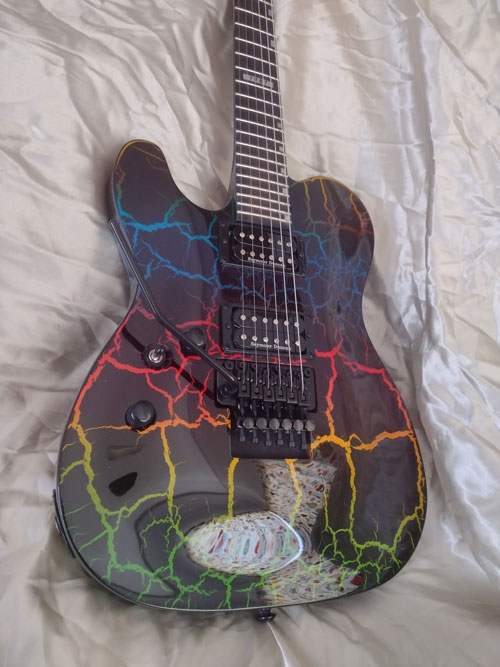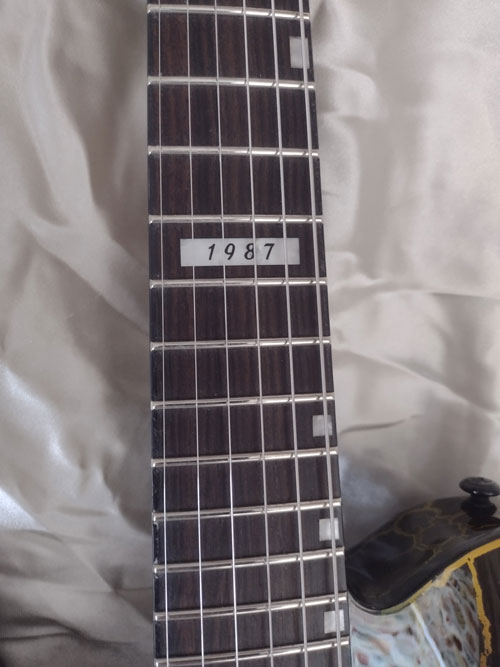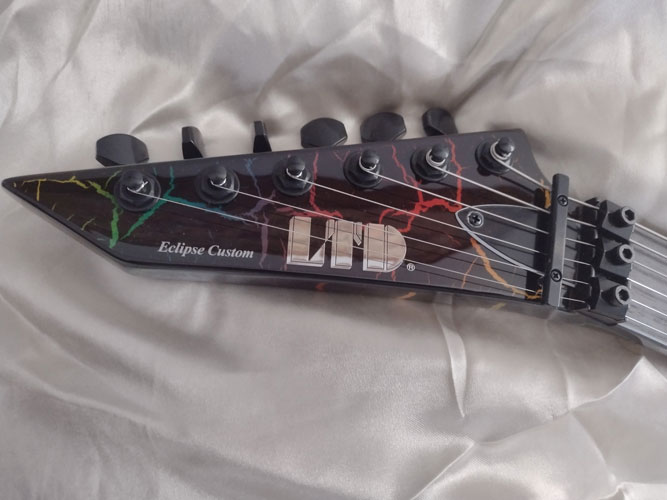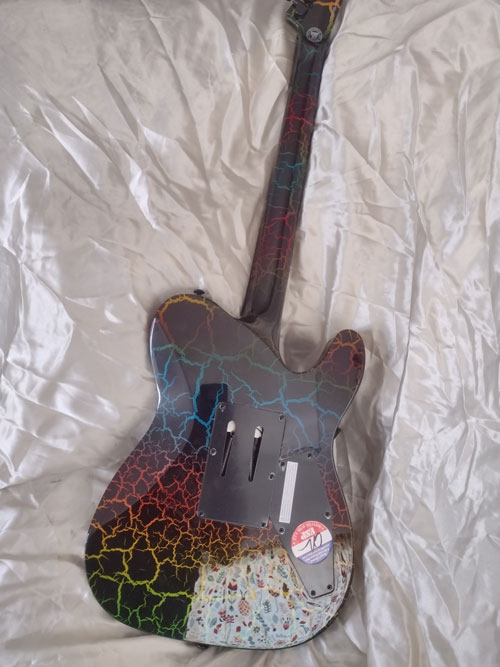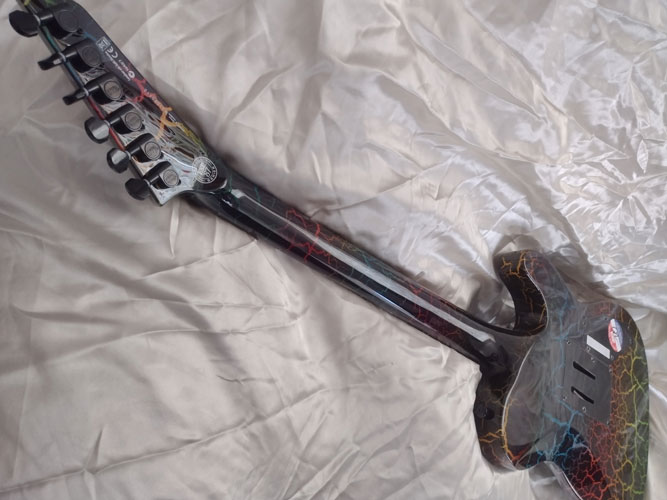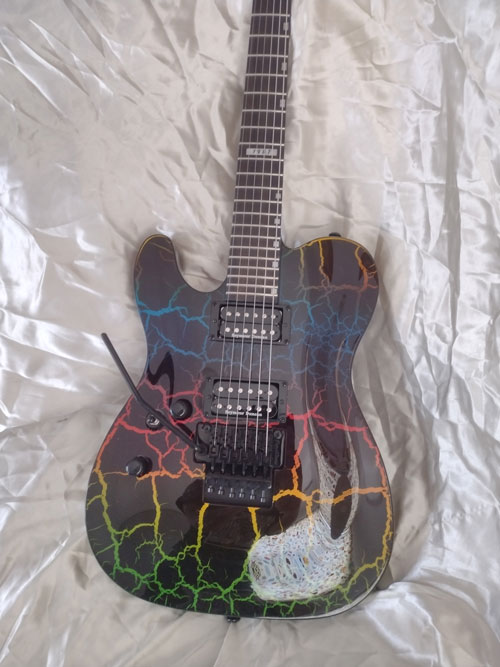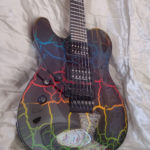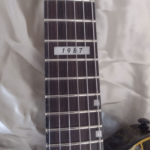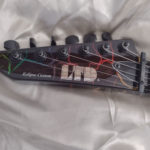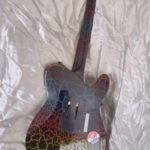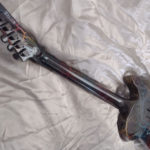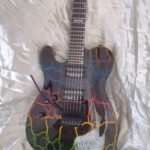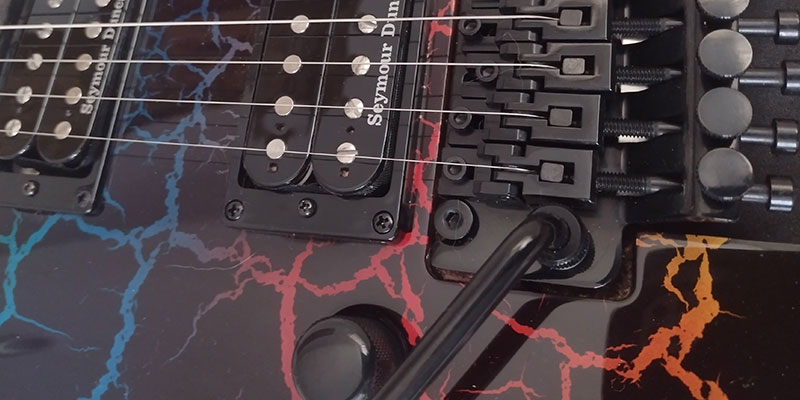Guitar Review: ESP Eclipse ’87 Electric Guitar Rainbow Crackle
ESP/LTD Eclipse '87 Electric Guitar Rainbow Crackle
So first impressions- this guitar is beautiful. Looking over every square inch of the finish, I can’t see a single flaw. The binding, as well as all the paint job itself are immaculate. Even the upper fret access cuts, and all areas of the painted neck and headstock are “rainbow crackled” under a professionally polished and buffed clear coat. The clear coat is on the thick side, but this makes the crackle effect really pop in person. The LTD logo looks great, as it floats within the clear coat suspended above the paint. I should note that the “rainbow crackle” finish itself looks spectacular, and uses more base colors than similar finishes offered by other manufacturers. The crackle pattern on each guitar is unique, since it’s the result of a chemical “peeling” process as opposed to a design that’s printed on.
Before we get too deep in, let’s look at some of the fun-yet-superficial little details on this thing. First, we’ve got the “1987” 12th fret inlay. I’m an 80s guy, so I can appreciate that. The side-set square fret marker inlays weren’t my favorite initially, but they’re growing on me, and are actually pretty low-key. There’s an “ESP re-issue” trademark silk screened on the back of the headstock, and a cool LTD logo and printed on the front. The instrument says “hand crafted in Korea” on the headstock, and there is also a neck volute.
The neck heel is carved, and since there neck itself is neck-through-body construction (the neck is a single piece of wood that extends through the length of the entire guitar), there is no heel plate. This is also undoubtedly the reason this guitar has a painted neck, as opposed to the M-1 from the same series which does not (the M-1 has a bolt on neck). The feel of the upper frets is especially nice, as the cut up to the bottom horn is a bit more wide and open than a traditional Telecaster. This combined with the heel carve, neck shape, and XJ frets is more than comfortable.
Working our way up the guitar, the FR 1000 bridge plays like a dream. The set-up is perfect (Thank you DCGL!), and it has no problem floating steady, ready to pull up, flutter, dive, and do whatever before returning in-tune every time. I have various other FR bridges of different makes and models, and this probably compares in build quality to the original high-end FR bridges from back in the 80s. The real difference between this and the 1500 series, is that the 1000 series bridges use a higher quality metal in some of the components used. If you’re a guy who pounds on the whammy bar, or even just uses it fairly often, this will make a difference sooner or later, as the better metals last a lot longer.
The “thin-U” neck feels great. Not super-shredder thin, but definitely not as chunky as a Les Paul, or even a strat for that matter. Apparently, the other option in this series, the M-1, DOES have a super-thin U style neck, so maybe consider one of those if that’s your thing. However, with the Eclipse’s 24.75” scale length, and T-style body, I feel like other overall tactile-style of this guitar is running far, far away from “super strat” territory on purpose.
Now, that’s not to say that this bad boy isn’t SUPER. The pickups alone… are freakin’ NICE. There’s a Seymour Duncan ‘59 in the neck position, and a Seymour Duncan JB in the bridge. Both pickups can be “coil split” by pulling on the volume knob, which turns both humbuckers into single coil pickups. While in humbucker mode, the JB is nice and loud, with a moderate upper mid and high end boost that makes for a really good, crunchy distorion. It’s also fine for cleans, as ultimately it’s not a naturally overdriven pickup. In single coil mode, it’s a lot more crisp and snappy, but not as loud. The ‘59 pickup in the neck is also about half as loud in single coil mode, but will give you a sweet, glassy clean tone. In humbucker mode it’s still a nice clean tone, but has a lot more volume, fullness, and midrange to it. Overall, I’d say it’s similar to modern Les Paul when in humbucker mode, but sounds a lot more like a Telecaster when in single coil mode. The overall tone coming out of the pickups really is a “late 80’s/early 90’s” palette of sound. The pickups aren’t quite over the top enough to be “modern”, but are great for shimmering 80’s clean tones, as well as thrash metal or hard rock from the same era. Not even joking, I literally found myself saiying “Wow”, and “Oh my gosh”, as I was going through the amp-simulation test rounds with this axe- that’s how good it sounded.
The guitar’s play is top of the line as well. The 24.75” scale length is very comfy for Les Paul players, and might even seem a bit “faster” for those who are used to playing 25.5” necks. The painted neck is not a problem for me, but if you like sanded or natural finished necks, then this might suck for you (yes, it’s glossy). The fret work is also extremely well done, and IMO lacks nothing. It also features 24 extra jumbo frets. This is definitely a premium instrument, and even when compared to other guitars in the same price range, feels like an incredible value.
Don’t let the crazy 80s finish fool you! This is obviously a great guitar to have if you want one axe that “does it all”, across most popular genres and playing situations. You pretty much have most genres of music covered tone-wise, and you have a double locking whammy bar that you can use (or not). Depending on your situation, you might be playing a wide variety of music (i .e. be in a top-40 band), and want one main gigging instrument. Perhaps you want to outfit a recording studio with a single guitar to cover a wide range of potential clients and their needs. This guitar was purchased from Drum City Guitar Land in CO, and I have to give them a shout out since their customer service was spot on, and their in-house complimentary guitar set up was absolutely top-notch. Literally one of the best set-up jobs I’ve ever had, and I’ve paid pro techs for more than a few.
